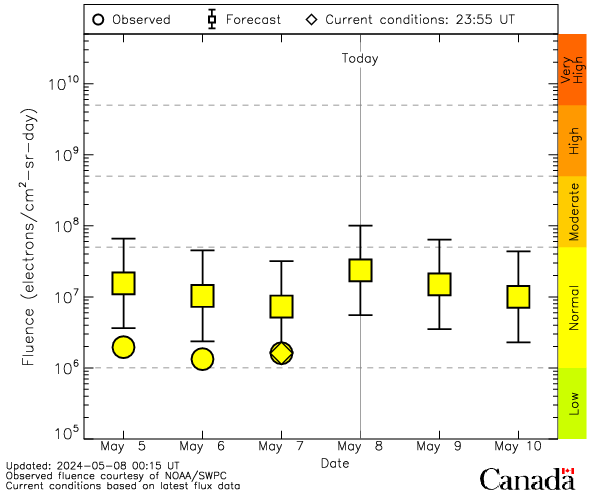Review and forecast of energetic electron fluence
Notice
Due to resource optimization, we plan to discontinue this product. For your inputs, please contact space_weather-meteo_spatiale@nrcan-rncan.gc.ca
Table of contents
Review and Forecast of Energetic Electron Fluence (Graphic)

The plot shows forecasts (indicated by squares with error bars) of fluence (flux accumulation over 24 hours) of highly energetic (relativistic) electrons with energies > 2 MeV at an altitude of 6.6 Earth radii in geosynchronous orbit. Observed values of fluence (indicated by circles) from GOES satellite, courtesy of NOAA/Space Weather Prediction Center, Boulder, USA, are also shown on the plot. The error bar represents the standard deviation. Current conditions (indicated by diamond on the plot) refer to fluence that is calculated from the latest 24 hours of GOES satellite electron flux data, courtesy of NOAA/Space Weather Prediction Center, Boulder, USA. The dashed line demarcating "Normal" and "Moderate" at 5.0E+07 electrons/cm2-sr-day is a threshold for adverse space weather conditions hazardous to geosynchronous satellites. When fluence is above the threshold, there is a likelihood of internal charging of satellite components by energetic electrons, with possible electric discharges that could result in malfunction or even complete failure of the satellite. The fluence forecast is based on the algorithm of Lam [2002; 2004], and the threshold value is from Wrenn and Smith [1996].
Review and Forecast of Energetic Electron Fluence (Text)
Note that the fluence values greater than the threshold value of 5.0E+07 electrons/cm2-sr-day are considered to indicate adverse space weather conditions hazardous to geosynchronous satellites.
| Current conditions at 2025-02-18 17:40 UT | 4.55E+7 electrons/cm2 - sr - day |
|---|
| Date UT | Observed | Forecast | ||
|---|---|---|---|---|
| Lower limit | Value | Upper limit | ||
| 2025-02-15 | 8.02E+7 | 3.29E+7 | 1.40E+8 | 5.98E+8 |
| 2025-02-16 | 1.14E+8 | 1.57E+7 | 6.86E+7 | 3.00E+8 |
| 2025-02-17 | 9.12E+7 | 2.81E+7 | 1.22E+8 | 5.35E+8 |
| 2025-02-18 | 1.23E+7 | 5.25E+7 | 2.24E+8 | |
| 2025-02-19 | 7.67E+6 | 3.27E+7 | 1.40E+8 | |
| 2025-02-20 | 4.49E+6 | 1.96E+7 | 8.56E+7 | |
Description
This forecast is a 3 day forecast of the > 2MeV electron fluence (flux accumulation over 24 hours). It consists of a range of forecast values for the current day and next 2 days. The fluence forecast and the observed fluence from the GOES satellite (courtesy of the NOAA/Space Weather Prediction Center in Boulder, USA) for the previous 3 days are also listed. Fluence values greater than 5.0E+07 electrons/cm2-sr-day are indicative of adverse space weather conditions hazardous to geosynchronous satellites. Under such conditions, there is a high likelihood of internal charging of satellite components by energetic electrons, with possible electric discharges that could result in malfunction or even complete failure of the satellite. The fluence forecast is based on the algorithm of Lam [2002;2004], and the threshold value is from Wrenn and Smith [1996].
References
Lam, H.-L., Prediction of relativistic electron fluence using magnetic observatory data, in Solar-Terrestrial Magnetic Activity and Space Environment (Proceedings of COSPAR Colloquium Beijing 2001), COSPAR Colloquia Series Vol. 14, 439-442, 2002.
Lam, H.-L., On the prediction of relativistic electron fluence based on its relationship with geomagnetic activity over a solar cycle, Journal of Atmospheric and Solar-Terrestrial Physics, 66, 1703-1714, 2004.
Wrenn, G. L. and R. J. K. Smith, Probability factors governing ESD effects on geosynchronous orbits, IEEE Trans. Nuc. Sci., 43, 2783-2789, 1996.